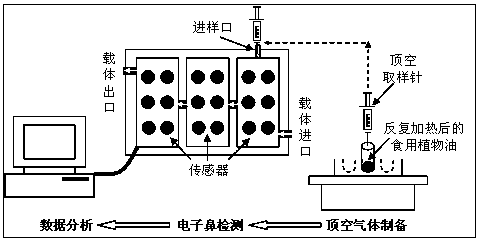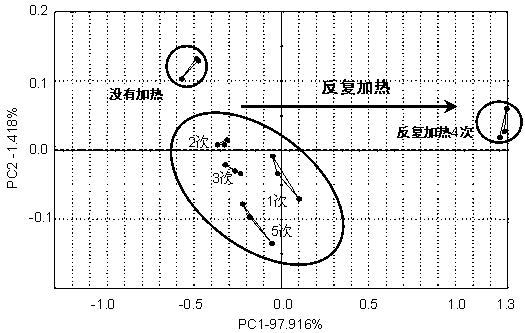Method for detecting repeated heating of edible vegetable oil by use of electronic nose
A technology of edible vegetable oil and repeated heating, applied in measuring devices, material analysis through electromagnetic means, instruments, etc., can solve the problems of large sample volume, complicated operation methods, long detection time, etc., and achieve less sample usage, The sample processing method is simple and the effect of rapid non-destructive testing
- Summary
- Abstract
- Description
- Claims
- Application Information
AI Technical Summary
Problems solved by technology
Method used
Image
Examples
Embodiment 1
[0027] Example 1: Electronic nose detection technology distinguishes edible soybean oil that has been repeatedly heated;
[0028] Prepare edible vegetable oil that is heated repeatedly: Use the "frying mode" (300 W) of the induction cooker for edible vegetable oils of common brands on the market, heating for 60 minutes, cooling to room temperature, and then performing the next round of heating for a total of 5 times. The heated sample is placed in a glass bottle, sealed and kept away from light at room temperature. Set up 3 replicates, each with 500 g edible vegetable oil.
[0029] Prepare a sample of edible soybean oil that is heated repeatedly, refer to figure 1 The flow chart shown develops the electronic nose technology to detect repeatedly heated soybean oil. Accurately weigh 2 g of samples, put them in a 10 ml sample bottle, and react at 34°C for 15 min, extract 2 ml of headspace gas, and inject it into the injection port of the electronic nose. The data generated by 18 sens...
Embodiment 2
[0031] Example 2: The electronic nose technology distinguishes repeatedly heated sunflower oil, rapeseed oil, corn oil and peanut oil.
[0032] Using the established electronic nose technology detection system, the effect of repeated heating on other edible vegetable oils was also studied. The results showed that after repeated heating of edible oils such as peanut oil, sunflower oil and corn oil, the quality of the samples changed. The characteristic value of odor was outside the upper and lower control limits of the SQC quality control model, while the normal edible oil without heating was in the control limit. Within ( Figure 8-10 ). For example, heated Duoli brand sunflower oil is different from unheated edible oil. As the number of repeated heating increases, the difference between the sample and the control sunflower oil becomes more and more obvious, showing the odor characteristics of sunflower oil after 5 repeated heating. The value is farthest from the standard of th...
PUM
 Login to View More
Login to View More Abstract
Description
Claims
Application Information
 Login to View More
Login to View More - R&D
- Intellectual Property
- Life Sciences
- Materials
- Tech Scout
- Unparalleled Data Quality
- Higher Quality Content
- 60% Fewer Hallucinations
Browse by: Latest US Patents, China's latest patents, Technical Efficacy Thesaurus, Application Domain, Technology Topic, Popular Technical Reports.
© 2025 PatSnap. All rights reserved.Legal|Privacy policy|Modern Slavery Act Transparency Statement|Sitemap|About US| Contact US: help@patsnap.com



